
How is Electricity Generated Now?
There are currently three main ways that we generate electricity:
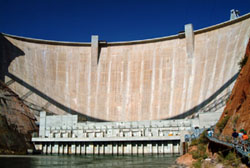 Fossil Fuels—Power plants burn fossil fuels to create electricity.
Fossil Fuels—Power plants burn fossil fuels to create electricity.
Nuclear Power—Atoms are split, which heats water to create steam that turns a turbine to create electricity.
Hydroelectric Power—Water runs through a dam and turns a turbine to generate electricity.
What Are Some Alternate Energy Sources?
Some alternate energy sources include:
Solar Energy
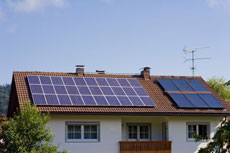 Solar power is power from the sun. Common uses of solar power include calculators, road signs with blinking lights and sometimes outdoor lights that are not close enough to a power outlet on a building. These are small uses, but it is possible to power an entire house using solar energy!
Solar power is power from the sun. Common uses of solar power include calculators, road signs with blinking lights and sometimes outdoor lights that are not close enough to a power outlet on a building. These are small uses, but it is possible to power an entire house using solar energy!
To create power from the sun, solar cells, also called photovoltaic cells, convert sunlight into small amounts of electricity. When many solar cells are used together on a solar panel, electricity is generated.
Solar energy is a good energy source because it is a renewable resource. As long as the sun is shining, solar electricity can be produced.
But what about nighttime when the sun isn’t shining or cloudy days when the sun isn’t out? During these times, there isn’t enough sunlight to generate electricity.
Houses can save up for a rainy day by storing solar energy in a battery.
Most houses that are powered by solar energy also have other power sources, such as the local utility, as a back-up. On days when the solar panels don’t collect enough electricity to power the house, electricity is drawn from the battery or back-up system.
Wind Energy
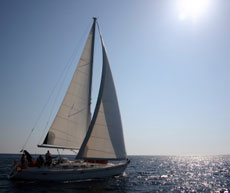 Wind is used for many things like flying a kite, sailing, hang gliding and even making electricity. Like solar power, wind power is also a renewable resource.
Wind is used for many things like flying a kite, sailing, hang gliding and even making electricity. Like solar power, wind power is also a renewable resource.
Wind energy can actually be considered a form of solar energy. The sun heats the earth and its atmosphere unevenly because different parts of the earth’s surface (like dirt, rock and water) heat up at different rates. With this uneven heating, warmer air rises above cooler air. As warm air moves around cooler air, wind occurs.
More About Wind Energy
 We can use the force of the wind to turn a turbine to generate electricity.
We can use the force of the wind to turn a turbine to generate electricity.
A wind turbine works the opposite of a fan. A fan’s blades are turned by electricity, creating wind to cool us off. A wind turbine’s blades are turned by the wind, creating electricity.
Wind energy can be produced in large amounts or small amounts.
Some utilities use wind farms. Wind farms have many large wind turbines working together to catch the wind.
On a smaller scale, homeowners and remote villages sometimes use smaller turbines to supplement their energy supplies. Farms often use wind power to pump water.
Biomass Energy
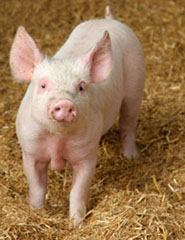 Bioenergy ranks second behind hydropower in the United States in amount of power generated by renewable resources.
Bioenergy ranks second behind hydropower in the United States in amount of power generated by renewable resources.
Energy from biomass is called bioenergy. Biomass means any organic matter derived from plants. Biomass energy includes agricultural crops, crop wastes and residues, wood wastes, aquatic plants and even animal wastes.
Researchers are currently working on a way to turn pig manure into a form of crude oil that can be refined to generate electricity. Scientists use intense heat and pressure to break down the pig manure into oil. This is very similar to the natural process that creates oil found in the earth, but instead of the process taking centuries, the process could take less than an hour.
Much more research will be required to see if the process could be practical for widespread use, but scientists are working on it! What will they think of next?!
Geothermal Energy
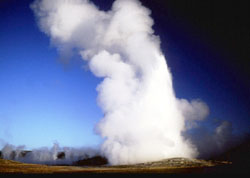 Geothermal energy refers to creating energy by using heat from the earth. “Geo” means “earth” while “thermal” means “heat.”
Geothermal energy refers to creating energy by using heat from the earth. “Geo” means “earth” while “thermal” means “heat.”
Resources for geothermal energy can come from shallow ground or hot water and hot rock found a few miles under the earth’s surface.
The earliest type of geothermal energy production was from dry steam. In this case, steam from deep within the earth is pulled to the surface where it turns a turbine to create electricity.
Most of the geothermal energy produced today is by the “flash steam method.” Water at temperatures of more than 360 degrees Fahrenheit is pumped from deep under the earth’s surface at a very large pressure. When it reaches the earth’s surface, the pressure is reduced, which allows the the water to quickly change—or flash—into steam. The steam turns a turbine to produce electricity.
In another form of geothermal energy production, hot water from the earth is used to heat another liquid that is vaporized to turn the turbines to create electricity. This method allows geothermal energy plants to use fluids that vaporize at lower temperatures than the boiling point of water. This means that it takes less heat to produce the energy.
Steam formed by heat from within the earth lifts from this geyser.
A Final Word
 In the near future, you will likely hear more and more about each of these alternate ways of producing electricity.
In the near future, you will likely hear more and more about each of these alternate ways of producing electricity.
Alternate energy sources may one day provide a majority of our country’s electricity if processes can be perfected to allow large amounts of energy to be produced at a low cost with minimal impact on the planet.
